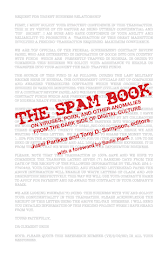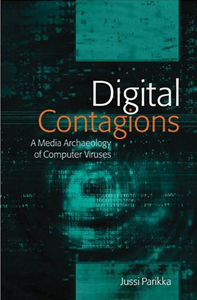
Adrian Mackenzie captures something extremely essential and apt in his fresh book Wirelessness - Radical Empiricism in Network Cultures (2010). Besides being an analysis of an aspect of contemporary "network" culture so neglected by cultural analysers, it offers a view into how does one conduct post-phenomenological analysis into the intensive, moving, profiliterating aspects of experience in current media culture. So much of what seems wired is actually wireless; so much of what seems experienced, is actually at the fringes of solid experience, which is why Mackenzie sets out to use William James's exciting philosophical theories of radical empiricism as his guide to understanding wirelessness.
Let's define it, or let Mackenzie define it:
"The key claim of the book is that the contemporary proliferation of wireless devices and modes of network connection can best be screened against the backdrop of a broadly diverting and converging set of tendencies that I call 'wirelessness'. Wireless designates an experience trending toward entanglements with things, objects, gadgets, infrastructures, and services, and imbued with indistinct sensations and practices of network-associated changed. Wirelessness affects how people arrive, depart, and inhabit places, how they relate to others, and indeed how they embody change." (5)
Indeed, Mackenzie does not remain content to just stick to the techy details or the phenomenology of how it feels to be surrounded by wireless devices and discourses, but sets out to treat these as a continuum. This too follows from James. Things go together well with our minds/brains. Thoughts are very much things even if at the other end of the spectrum than the more seemingly solid things of the world. Thinking and things cannot be separated. Mackenzie quotes James: "Thoughts in the concrete are made of the same stuff as things are." The stuff of continuum.

Hence, what follows is also methodologically exemplary treatment of this weird phenomena of wireless communication. Already in its early phase, the fact that communication started to remove itself from solid bodies and the messaging human body, was a topic of awe and wonderment. James was roughly a contemporary to the buzzing discourses of electromagnetic fields and experiments in wireless communication closer to the end of the 19th century by such figures as Preece, Willoughby Smith and of course Marconi; this media archaeological aspect is not so much touched upon by Mackenzie. In any case, one would do well to look at it's 19th century radical empiricist discourses as well, to examine the way bodies, solids, experience and media were being rethought in those early faces, here described in the words of one pioneer and early writer Sir William Crookes:
" Rays of light will not pierce through a wall, nor, as we know only too well, through London fog; but electrical vibrations of a yard or more in wave-length will easily pierce such media, which to them will be transparent." (quoted in J.J.Fahie, Wireless Telegraphy, 1838-1899, p.197).
Even if not transparency, wirelessness affords new senses of mobility. For us, wireless is heavily an urban phenomena (even if touches on how rural areas are being connected, peripheries harnessed, and now, also, the human body and its organs individually connected to the internet with new wireless device surgery). For Mackenzie, the mobility relates to "transitions between places" and how such hotspotting of for example the urban sphere creates new forms of intensity that are not stable. In his earlier book Transductions Mackenzie was using Simondon's vocabulary which offered the idea of the primacy of metastability, now James is doing the same trick with offering a conceptual vocabulary for an experience that is distributed, diffuse and coming and going.
What is fascinating is how Mackenzie moves between the various scales, and still is able to keep his methodology and writing intact. In addition the fact that the urban ex
 periences of humans is being enabled by the variety of wireles devices, networks, accesses, and so forth, he is after such radical technological experience where hardware and software relations within technology matter as well. Talking about chipsets such as the Picochip202, Mackenzie compares these to cities: "The 'architectures' of chipsets resemble cities viewed from above precisely because they internalize many of the relational processes of movement in cities." (65).
periences of humans is being enabled by the variety of wireles devices, networks, accesses, and so forth, he is after such radical technological experience where hardware and software relations within technology matter as well. Talking about chipsets such as the Picochip202, Mackenzie compares these to cities: "The 'architectures' of chipsets resemble cities viewed from above precisely because they internalize many of the relational processes of movement in cities." (65).The way bodies were moved and managed in urban environments has now been transposed as a problem on the level of chips and other seemingly "only" technical solutions. Yet, what Mackenzie does succesfully is to show how we need insights into such biopolitics that engage not only with human phenomenological bodies, but biopolitics of technological bodies too. This is what I find a very exciting and necessary direction, and while I know some of the great work done in Science and Technology studies, more media studies work in this direction of new materialism is very much welcome.
So now that we got talking about technological bodies in relation, and probably going soon so far that we could say that they have affects, would some critic say, does this not mean that we losing our grip on politics -- that technology is such a crucial way of governing our worlds, offering meanings, and is itself embedded in a cultural field of representation and such?
Mackenzie does not however neglect representations, or the variety of materials of which the experience of wirelessness consists; from wireless routers to marketing discourses and adverts, the ontological claim that thinking and things do not differ work also as a methodological guideline for rigorous eclectism. Similarly, Mackenzie shows how his methodology and writing lends itself also to postcolonial theory in chapter 7 "Overconnected worlds". Here, the claim is consist with a radical constructedness inherent in how transnationality and the global are created, not received, structures of experiencing; here, various wireless projects offer such platforms for both belief as well as physical connection.
Wirelessness overflows individual bodies and act as a catalyzer, intensifier, a field for experience perhaps in the sense as electromagnetic fields afford the technical signal between devices. What the book does as well is overflows in its richness - but it is clear that it is so rigorous in its take that media theory benefits from this for a long time. It picks up on some of the same inspiration that has been catalyzed into more philosophical takes on communication and contemporary culture by Brian Massumi, but is one of the first ones to take this mode of analysis of lived abstractions into concrete media analysis - similarly as he did with Simondon already in Transductions.













